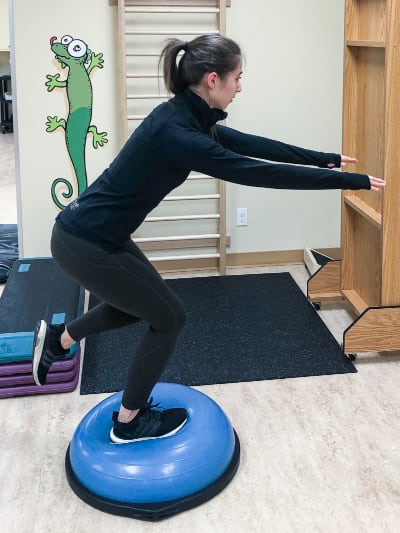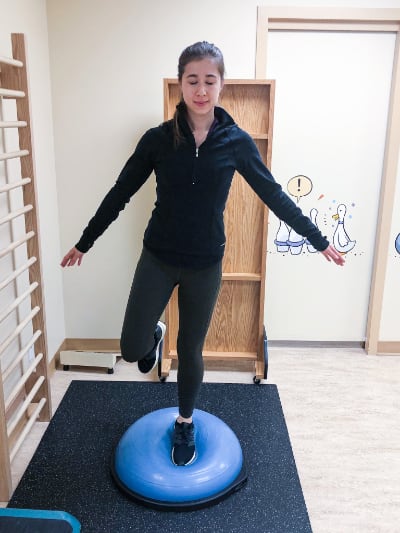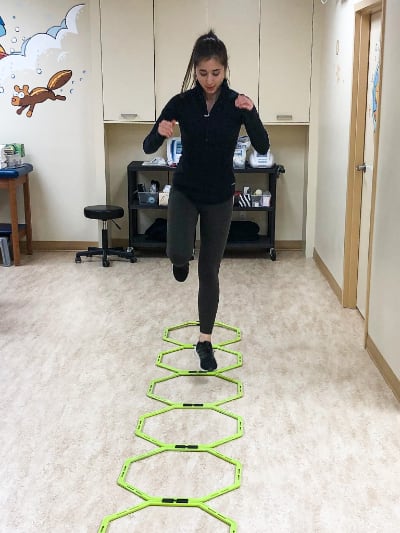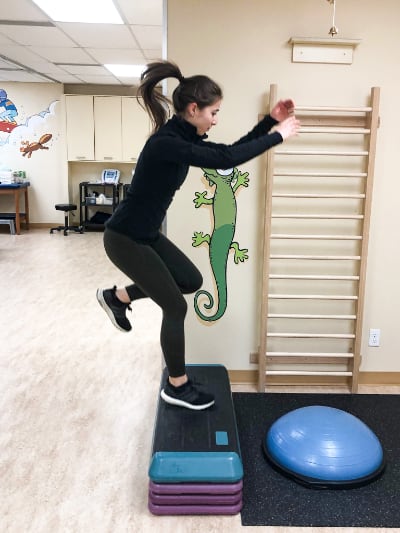Blog
Proprioception: The secret to preventing recurrent ankle sprains
Why do bad sprains happen to good people?
Proprioception: The secret to preventing recurrent ankle sprains
By Andrea Ginter, Physiotherapist, BSc MScPT
After an ankle sprain, many people experience recurrent sprains of the same ankle even years later. Patients who have diligently completed exercises to strengthen the ankle after the original sprain can still fall into this pattern of recurrent injury. Often, the reason for this is that even though the ankle has regained normal strength, it has not been trained in the right way to regain proprioception.
Proprioception is our body’s ability to tell where it is in space. Receptors in our joints send information to our brain about the position of our limbs. This positional sense is called proprioception, and it is an important component of balance and agility.
Lower extremity exercises like resistance band training are important for recovery as they are good at building strength, but they do not train proprioception. When proprioception training is missed, it is very likely that a patient will re-sprain their ankle, even if the patient “feels” like the ankle is back to normal.
The exercises below are designed to re-train lower extremity proprioception. To train proprioception, we need to challenge the leg’s ability to self-stabilize. There are a number of ways to do this, including multi-direction jumping drills, balance tasks (especially with the eyes closed, as vision contributes to our sense of balance, and therefore can mask poor proprioception), and agility tasks.
Physiotherapists are experts in recovery after sprains. A skilled physiotherapist will ensure that after injury, a patient has recovered all areas of performance including strength, endurance, balance, agility, and proprioception, to stop the cycle of recurrent injury.
Exercises for Lower Extremity Proprioception
 |
1. Single leg squat on unstable surface Stand on one leg. Bend the knee and reach the hips backwards as if you were sitting into a chair. Stand on a wobbly surface such as a folded yoga mat, pillow, or bosu ball. Ensure that the hips stay level and the knee of the standing leg points forwards. |
 |
2. Balance tasks with eyes closed Practice balance tasks with eyes closed so that instead of relying on vision, you rely on your joint receptors to help you balance. Find a foot position that you can maintain safely. A bit of slight ankle shakiness is normal. Here are some options for foot position, listed from easiest to most difficult: standing feet together, tandem stance (one foot directly behind the other), single leg stance. First, master balancing on a flat stable surface. Once your skill level has increased, add a soft surface under your feet to increase difficulty. |
 |
3. X-Jumps Jump on one foot hopping forwards and backwards, or side to side. Use small, fast jumps with good control, staying close to an X taped on the ground. Create your own pattern of hops that includes all directions, such as jumping forward, backward, right, then left. |
 |
4. Agility ladder drills An agility ladder can be fashioned from painters tape or sidewalk chalk. Practice a wide variety of drills, working up to fast speeds. Good movements to practice include single leg hopping, quick sideways cutting, and fast foot movements in/out of the ladder travelling forwards or sideways.Running with quick changes in direction are another way to build proprioception and agility. Cones can be set up to indicate the point of quick pivot direction change. |
 |
5. Plyometrics Plyometrics are advanced and powerful jumping drills. Examples include box jumps, or jumping down off of a safe height and using the power on landing to jump upwards immediately. |
